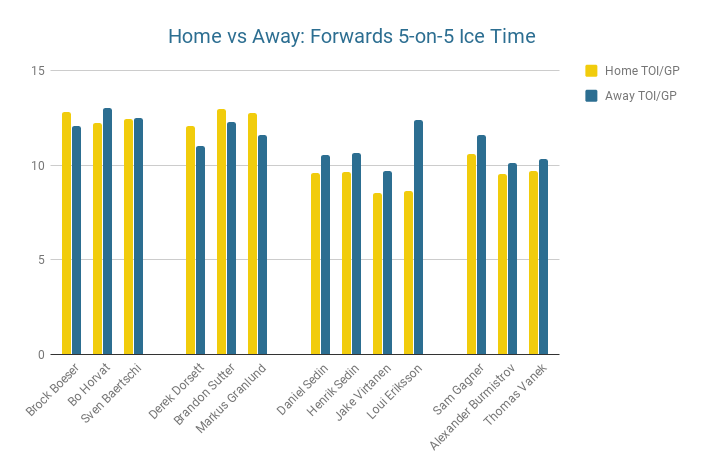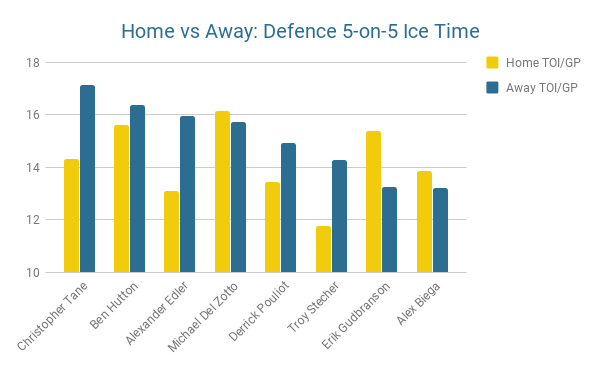On the road, the Canucks have been one of the best teams in the NHL. They’re tied with the Toronto Maple Leafs for the most road wins with 9 and have a 9-5-1 record.
At home, it’s a completely different story. Only the Arizona Coyotes have fewer home wins this season and their 3-5-3 record at Rogers Arena is an ugly blot on what has been a solid start to the season. It’s tough for the hometown fans to face loss after loss on home ice.
With a win against the Nashville Predators, their recent road trip ended as mostly a success, but with 11 of their next 14 games at home, the Canucks need to start winning in Rogers Arena.
So, what is happening? Why can the Canucks win on the road but not at home? As is usually the case with hockey, it likely comes down to a combination of many factors.
One possibility that has been brought up is that Travis Green is over-matching when he is at home. I’ve seen it or heard it in several places, such as here in the PITB comments section or when I was a guest on Sportsnet 650 with Dan Riccio.
In most sports, having a home advantage usually just refers to having your home fans in attendance cheering you on. Depending on the sport and the fans, that home advantage can still be very real: witness the 12th Man in Seattle or the profound home-field advantage enjoyed by MLS teams across the league.
In hockey, however, there is at least one home-ice advantage built right into the rules: the home team gets last change. This means that any time there is a stoppage in play, the visiting team has to put their players on the ice first, allowing the home coach to see who they’re sending out and choose his players in response.
For a coach that likes to line-match, this should be an advantage. You can counter their best forwards with your top defencemen and shutdown line and get your scoring line out against their fourth line.
It can also get you in trouble, allowing the visiting team to, in a sense, dictate your deployment. A savvy coach could manipulate the home coach to keep his best offensive players on the bench as much as possible.
Without last change on the road, line-matching gets a little bit more difficult. In order to get the matchup you want as a coach, changes have to be made on the fly. It’s doable, of course, but it lends itself a lot more to just putting your best lines on the ice as much as possible after a stoppage in play.
Is this what’s happening with Travis Green and the Canucks? Is he over-thinking his deployment and using his shutdown line too much at the expense of his more skilled players?
Perhaps. I hesitate to criticize Green too much at this point: he’s gotten a lot out of this Canucks roster so far this season. And one of the issues is that the Canucks score at about the same rate at home and on the road, but give up more goals on home ice. That would be an argument against, unless you have a particularly low view of Sutter's abilities as a shutdown centre.
In any case, the Canucks' performance on home ice is till a concern and it's worth exploring this idea to see if it bears fruit. What would it look like if the Canucks’ last change at home did lead to using the shutdown line more? We would expect to see Brandon Sutter and his linemates get a boost in 5-on-5 ice time at home, while the Canucks’ more offensively-inclined players saw less ice-time. Is that the case?

Sort of. We do see a small boost in ice-time at home for the shutdown line, about a minute per game for Derek Dorsett and Markus Granlund, and closer to half-a-minute for Sutter. But that doesn’t seem significant enough to make a huge difference.
Meanwhile, the Sedins and their linemates have definitely received more ice time on the road, but some of that has come because Sutter has been injured. The ice time for Loui Eriksson is a big jump, however, and his excellent play since coming back from injury has been a difference maker.
Then there are smaller boosts for Sam Gagner, Alexander Burmistrov, and Thomas Vanek on the road, while the top line of Brock Boeser, Bo Horvat, and Sven Baertschi has only a small variance.
That just doesn’t seem to be the answer. Sutter basically gets the equivalent of one extra shift when he’s at home: that doesn’t scream over-matching lines with the last change at home.
There’s one other aspect of line-matching, however, that arguably plays a larger role: the defence. What are the home and away splits for ice time for the Canucks’ defence?

Whoa.
That’s not a small difference. Chris Tanev and Alex Edler average nearly three minutes of 5-on-5 ice time less per game at home than they do on the road. Troy Stecher is closer to two-and-a-half minutes less at home.
Picking up those extra minutes? I’m less inclined to read too much into the big home boost in ice time for Erik Gudbranson, partly because he had to fill in for the injured Tanev and partly because his away ice time is skewed due to his five-minute major in Boston and his own injury in Pittsburgh.
Tanev’s ice-time split, however, isn’t affected by those factors, so that nearly three-minute gap is fascinating to me. Is that a result of line-matching at home? Is Travis Green so intent on getting Tanev out against the opposition’s best forwards that he actually plays him less?
You might suggest that maybe his ice-time is skewed by an excess of penalty kills at home, which might lead to less 5-on-5 ice time, or something along those lines. But the gap persists even when you look at ice time in all situations: Tanev has received significantly less ice time at home this season.
I’m honestly not sure what to make of this. A few minutes less per game for one player should not make or break a team, but Tanev is the Canucks’ best defenceman. Would a few minutes more of his steady defence and quick transition up the ice lead to a slightly different record on home ice?



